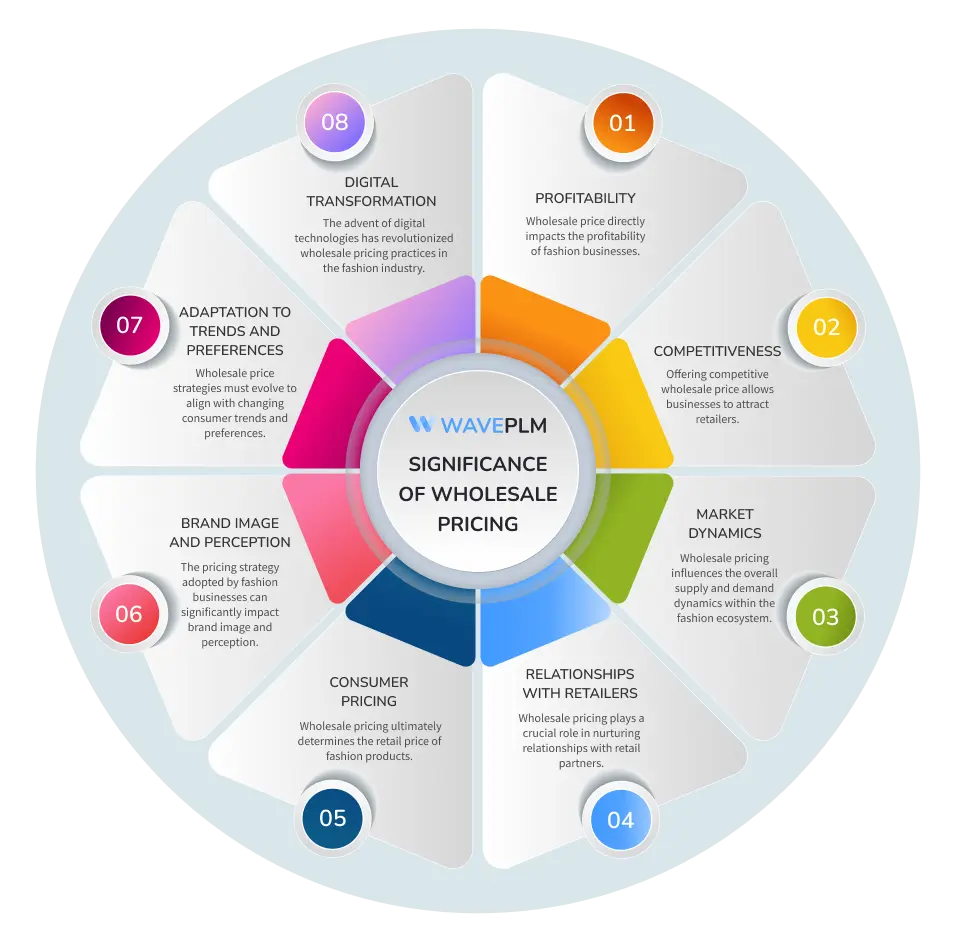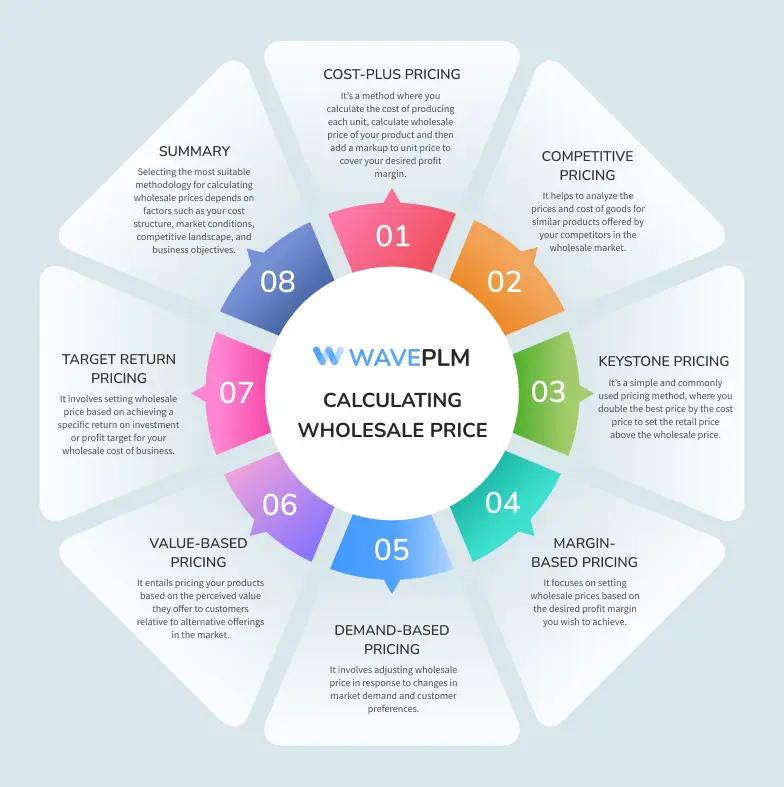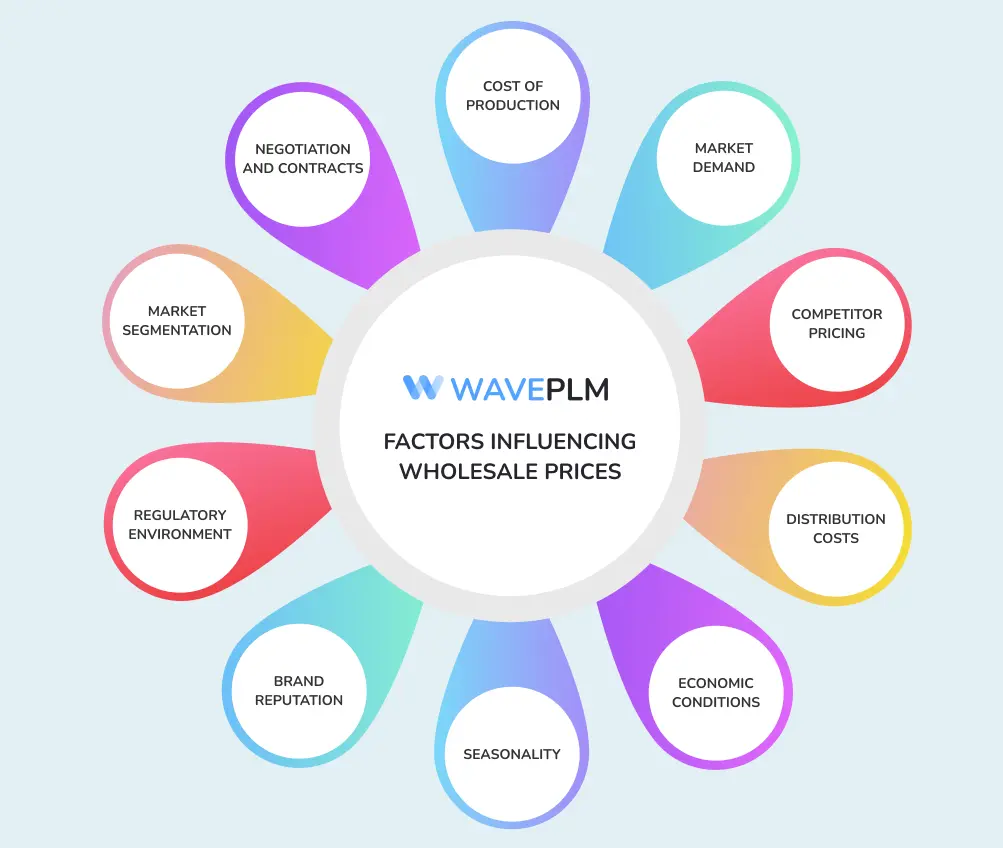
Introduction
In the dynamic realm of fashion, where trends morph swiftly and consumer inclinations fluctuate, comprehending wholesale and retail pricing is fundamental for designers, manufacturers, and retailers alike. But what is wholesale pricing? It stands as the bedrock of the fashion business, wielding influence over profit margins, market competitiveness, customer acquisition costs and overall prosperity.
This comprehensive exploration of bulk pricing aims to delve deeply into the complexities of how to calculate wholesale price and retail prices in the fashion industry, elucidating its significance, methodologies, influencing factors, and emerging trends.
What is Wholesale Pricing?
Wholesale pricing denotes the price difference from full cost of goods at which manufacturers or designers vend their products to retailers, typically in bulk or large quantities. It serves as the intermediary link between production and retail cost of goods, facilitating transactions that enable both parties to generate revenue.
In contrast to retail prices, which consumers directly encounter, wholesale prices are negotiated between suppliers and buyers, often with bulk discounts reflecting lower per-unit costs due to bulk purchasing.
Why is Wholesale Cheaper than Retail?
Wholesale customers may sell their product at a lower price and retail because it is sold primarily in bulk, allowing a lower price, quicker turnaround and lower labor costs. It usually delivers large quantities, although it is possible to order small quantities.
Significance of Wholesale Pricing
Wholesale and retail pricing also plays a pivotal role in shaping the dynamics of the fashion industry and has significant implications for profit margin and for price retailers across various aspects:

Profitability:
Wholesale price directly impacts the profitability of fashion businesses, including manufacturers, designers, and retailers. Setting the right wholesale price ensures that businesses can cover their production costs while generating a satisfactory margin to sustain operations and invest in growth initiatives.
Competitiveness:
In the highly competitive fashion industry, wholesale price can be a key differentiator. Offering competitive wholesale price allows businesses to attract retailers and secure placement in stores or online platforms. Additionally, pricing strategies such as discounts, promotions, and incentives can help businesses stand out in a crowded marketplace.
Market Dynamics:
Wholesale pricing influences the overall supply and demand dynamics within the fashion ecosystem. Fluctuations in wholesale prices can impact production levels, inventory management, and distribution channels. Understanding market trends and adjusting wholesale price accordingly enables businesses to adapt to changing market conditions and maintain a competitive edge.
Relationships with Retailers:
Wholesale pricing plays a crucial role in nurturing relationships with retail partners. Fair and transparent pricing practices help build trust and credibility with retailers, fostering long-term partnerships.
Consumer Pricing:
Wholesale pricing ultimately determines the retail price of fashion products. The wholesale price sets the baseline for retail markups, which in turn influence consumer perceptions of value and affordability. Balancing wholesale pricing with consumer expectations is essential for driving sales and maintaining brand relevance in the market.
Brand Image and Perception:
The pricing strategy adopted by fashion businesses can significantly impact brand image and perception. Premium pricing strategies signal quality, exclusivity, and luxury, positioning brands in the higher-end segment of the market. Conversely, value-oriented pricing appeals to budget-conscious consumers, positioning brands as accessible and affordable.
Adaptation to Trends and Preferences:
Wholesale price strategies must evolve to align with changing consumer trends and preferences. As consumers increasingly prioritize sustainability, ethical sourcing, and transparency, fashion businesses must consider these factors when setting wholesale prices.
Digital Transformation:
The advent of digital technologies has revolutionized wholesale pricing practices in the fashion industry. Online platforms and digital marketplaces offer new avenues for wholesale transactions, allowing businesses to reach a broader audience and optimize pricing strategies through data analytics and real-time insights.
Methodologies for Calculating Wholesale Price
Determining wholesale and retail price also entails comprehensively analyzing various cost factors and market dynamics. While there is price between wholesale and retail prices is no one-size-fits-all approach to selling or determining wholesale prices here, common methodologies encompass:

1. Cost-Plus Pricing:
Cost-plus pricing is a straightforward pricing method, where you calculate the cost of producing each unit, calculate wholesale price of your product and then add a markup to unit price to cover your desired profit margin. Start by identifying all direct costs associated with manufacturing your product, such as raw materials, labour, and manufacturing overheads. Next, calculate your indirect costs, including rent, utilities, and administrative expenses. Once you have your total cost per unit, determine the markup percentage you want to apply to final price to cover total material cost and your profit margin. This percentage should reflect your desired return on investment and account for any unforeseen expenses or fluctuations in the market.
2. Competitive Pricing:
Competitive wholesale prices effectively involves analyzing the prices and cost of goods for similar products offered by your competitors in the wholesale market. Conduct thorough market research to understand the pricing strategies of your competitors and the factors influencing their pricing decisions for wholesale products. Consider factors such as product quality, features, brand value, reputation, and customer service. Based on this analysis, set your wholesale price to be competitive while ensuring that you maintain your profitability and differentiate your offering from competitors selling wholesale elsewhere.
4. Keystone Pricing:
Keystone pricing is a simple and commonly used pricing method, where you double the best price by the cost price to set the retail price above the wholesale price. This approach is often employed in retail environments, where the manufacturer’s suggested retail price is typically set at twice the wholesale price index the cost price. While keystone pricing provides a straightforward way to determine wholesale prices, it may not always be suitable for all products or industries, as it may not accurately reflect the true value of the product or account for market demand.
5. Margin-Based Pricing:
Margin-based pricing focuses on setting wholesale prices based on the desired profit margin you wish to achieve. Begin by using different prices and determining the profit margin percentage that aligns with your business goals and financial objectives. Subtract this retail profit margin percentage from 100% to calculate the markup percentage required. Apply this markup percentage to the cost per unit of goods sold for your product to determine the wholesale price. This method allows you to maintain consistency in your wholesale pricing strategy while ensuring that your profit margins remain within your target range.
6. Demand-Based Pricing:
Demand-based pricing involves adjusting wholesale price in response to changes in market demand and customer preferences. Monitor market trends, customer behavior, and competitor pricing strategies to identify fluctuations in demand and wholesale costs for your products. During periods of high demand, you and other businesses may be able to increase wholesale price to please customers pay capitalize on increased consumer willingness to pay higher price. Conversely, during periods of low demand, you and wholesale business may need to lower prices to stimulate sales and remain competitive in the market.
7. Value-Based Pricing:
Value-based differentiated pricing also entails pricing your products based on the perceived value they offer to customers relative to alternative offerings in the market. Identify the unique features, benefits, and advantages of your products compared to competitors. Determine how much value customers attribute to these attributes and set your wholesale price accordingly. This approach to both differentiated pricing in wholesale pricing effectively allows you to capture the value you provide to customers and potentially command higher prices from wholesale customers than competitors offering similar products with fewer benefits or features.
8. Target Return Pricing:
Target return pricing involves setting wholesale price based on achieving a specific return on investment or profit target for your wholesale cost of business. Begin by determining the level of profitability you want to achieve for wholesale cost of your business and calculate customer acquisition costs. Calculate the total revenue required to reach this target by calculating customer acquisition costs and adding your desired profit margin to your total costs. Divide this total revenue by the number of units you expect to sell to arrive at your wholesale price per unit. This method ensures that your pricing strategy is aligned with your financial goals and helps you maintain profitability over time.
In summary, selecting the most suitable methodology for calculating wholesale prices depends on factors such as your cost structure, market conditions, competitive landscape, and business objectives. By carefully considering these factors and employing the appropriate, pricing methods and strategy, you can set prices that maximize profitability while without additional costs and remaining competitive in the market. Regularly review and adjust your wholesale price methods and pricing strategy to adapt to changes in the market and ensure long-term success for your business.
Factors Influencing Wholesale Prices
Wholesale pricing is influenced by a variety of factors, which can vary depending on the industry, market conditions, the production cost of goods manufactured, of goods manufactured and specific retail and wholesale business dynamics. Here are some key factors that commonly influence wholesale price:

Cost of Production:
The cost of production encompasses a wide range of expenses, including raw materials, labor wages, equipment maintenance, utilities, and facility overheads. Businesses need to accurately calculate these costs to establish a baseline for setting prices. Variations in costs, such as fluctuations in raw material prices or changes in manufacturing technology, can directly impact wholesale price strategies.
Market Demand:
Understanding market demand is crucial for determining the optimal pricing strategy. Wholesalers must gauge the level of demand for their products within their target market segments. Factors such as consumer preferences, trends, seasonality, and macroeconomic conditions all influence demand. By aligning pricing with demand, wholesalers can maximize revenue and minimize inventory holding costs.
Competitor Pricing:
Monitoring competitor pricing strategies provides valuable insights into market dynamics and helps wholesalers position their offerings effectively. Analyzing competitors’ pricing structures, discounts, promotions, and value-added services enables wholesalers to adjust their own pricing strategies to maintain competitiveness. Moreover, differentiation based on product quality, brand reputation, or customer service can justify premium pricing compared to competitors.
Distribution Costs:
Efficient distribution is essential for delivering products to customers in a timely and cost-effective manner. Distribution costs include transportation expenses, warehousing fees, inventory management costs, and fulfillment expenses. Wholesalers must optimize their supply chain operations to minimize distribution costs while ensuring product availability and reliability. Fluctuations in fuel prices, shipping rates, and inventory carrying costs can impact overall distribution expenses and influence price decisions.
Economic Conditions:
The broader economic environment significantly affects wholesale pricing dynamics. Economic indicators such as GDP growth, inflation rates, unemployment levels, and consumer confidence influence purchasing power and demand patterns. During economic downturns, wholesalers may face pricing pressures due to reduced consumer spending and intensified competition. Conversely, during periods of economic expansion, wholesalers may capitalize on increased consumer demand and adjust pricing strategies accordingly.
Seasonality:
Many industries experience seasonal fluctuations in demand, which necessitates flexible pricing strategies. For example, demand for outdoor recreational products peaks during the summer months, while demand for winter apparel surges in colder seasons. Wholesalers must anticipate seasonal demand patterns and adjust inventory levels and pricing strategies accordingly. Offering seasonal discounts, promotions, and bundled packages can help stimulate sales and mitigate inventory risks during off-peak periods.
Brand Reputation:
The reputation and perceived value of a brand influence consumers’ willingness to pay premium prices. Strong brands command customer loyalty, trust, and preference, allowing wholesalers to justify higher pricing levels compared to generic or lesser-known competitors. Investing in brand-building activities such as marketing campaigns, product innovation, and customer engagement initiatives can enhance brand equity and support premium pricing strategies.
Regulatory Environment:
Regulatory factors, including taxes, tariffs, trade agreements, and industry-specific regulations, impact costs and market access. Changes in regulatory requirements, such as environmental standards or import/export restrictions, may necessitate adjustments to pricing structures. Compliance with regulatory mandates also incurs additional administrative and operational costs, which must be factored into wholesale pricing calculations.
Market Segmentation:
Tailoring pricing strategies to different market segments allows wholesalers to address diverse customer needs and preferences effectively. By segmenting markets based on geographic location, demographic characteristics, purchasing behavior, or industry verticals, wholesalers can customize pricing, discounts, and promotions to maximize revenue and profitability. Adopting a targeted approach to pricing enhances customer satisfaction, fosters brand loyalty, and strengthens competitive positioning within specific market segments.
Negotiation and Contracts:
Wholesale pricing often involves negotiation with customers, distributors, and suppliers to reach mutually beneficial agreements. Establishing long-term contracts or volume-based pricing arrangements can provide pricing stability and predictability for both parties. Offering incentives such as quantity discounts, rebates, or exclusive deals incentivizes customers to commit to larger purchases or extended partnerships. Effective negotiation skills, supported by thorough market analysis and value proposition communication, are essential for securing profitable pricing agreements.

Emerging Trends in Wholesale Pricing
Wholesale pricing is a critical aspect of many industries, influencing supply and demand pricing, chain dynamics business costs, profit margins, overhead costs, absorption pricing, and market competitiveness. Several emerging trends are reshaping how various wholesale products and pricing strategies are formulated and implemented:
Dynamic Pricing:
This trend involves adjusting prices in real time based on various factors such as demand, inventory levels, and competitor pricing. Dynamic pricing algorithms analyze market conditions and consumer behaviour to optimize pricing strategies for maximum profitability.
Personalized Pricing:
Wholesalers are leveraging customer data to offer personalized pricing tailored to individual clients. By understanding each customer’s purchasing history, preferences, and behaviour, wholesalers can provide targeted pricing incentives, fostering stronger customer relationships and increasing loyalty.
Value-Based Pricing:
Instead of solely focusing on production costs, wholesalers are considering the perceived value of their products or services to customers. Value-based pricing aligns prices with the benefits customers derive, allowing wholesalers to capture a larger share of the value they provide.
Subscription and Membership Pricing:
Some wholesalers are adopting subscription or membership-based pricing models, offering customers access to exclusive products, discounts, or services for a recurring fee. This approach provides a predictable revenue stream while incentivizing customer retention and engagement.
Transparency and Fairness:
Wholesalers are prioritizing transparency and fairness in pricing practices to build trust with customers. Clear communication of pricing structures and terms enhances transparency, while fair pricing ensures that customers perceive the value they receive as commensurate with the price paid.
Sustainability and Ethical Pricing:
With increasing consumer demand for sustainable and ethically sourced products, wholesalers are incorporating these considerations into their pricing strategies. Ethical pricing may involve pricing products higher to reflect sustainable production practices or fair trade principles, appealing to conscious consumers.
Digital Platforms and Marketplaces:
The proliferation of digital platforms and online marketplaces has transformed wholesale distribution channels. Wholesalers are leveraging these platforms to reach a broader audience, optimize pricing strategies, and streamline transactions through automation and integration with other systems.
Blockchain Technology:
Blockchain technology offers opportunities to enhance transparency, traceability, and security in wholesale transactions. Wholesalers can utilize blockchain-based platforms to verify product authenticity, track supply chain provenance, and mitigate risks such as counterfeiting and fraud.
Data Analytics and Predictive Modeling:
Advanced data analytics tools enable wholesalers to gain insights into market trends, customer behaviour, and competitive dynamics. Predictive modelling techniques allow wholesalers to forecast demand, optimize pricing decisions, and identify opportunities for growth and efficiency.
Collaborative Pricing Initiatives:
Collaboration among wholesalers, manufacturers, and retailers in pricing initiatives can lead to mutual benefits such as cost savings and increased market reach. Joint pricing agreements and strategic partnerships enable participants to align pricing strategies, share resources, and create value for all stakeholders.
These emerging trends reflect the evolving landscape of the wholesale industry and retail pricing everywhere, driven by technological advancements, changing consumer preferences fair price,, and the pursuit of competitive advantage higher price and fixed costs,. Wholesalers must embrace innovation and adapt their pricing strategies to thrive in this dynamic environment.
Conclusion
What is wholesale price, a cornerstone of the fashion industry, which holds sway over a multitude of factors including profitability, market dynamics, and competitiveness of retail businesses. Understanding the intricacies of various wholesale pricing methods and methodologies and the evolving trends within the fashion landscape is paramount for businesses aiming to navigate the complexities of the market and drive growth and prosperity. In today’s climate marked by a heightened emphasis on sustainability, transparency, and digital innovation, the formulation of strategic wholesale pricing methods and strategies becomes not only essential for profitable retail business’, but also a critical tool for meeting the evolving demands of consumers and staying ahead of the curve in an ever-changing industry.





Leave a Reply